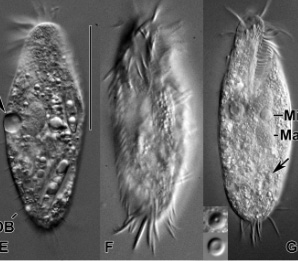Ciliates are protozoan organisms. They common almost everywhere there is water and often they form relationships with bacteria. There are roughly 8,000 species of Ciliophora known to date but species estimates go all the way up to 30,000.
Ciliates get their name from their method of locomotion: they swim using cilia, short, hairlike projections of cytoplasm composed of pairs of microtubules surrounded by cell membrane. Ciliates represent the most complex of cells, having an elaborate cytoskeleton, cilia and two different kinds of nuclei.
Today's new species was discovered in freshwater of King George Island, Antarctica. Its name was derived from King Sejong Station (Korea Antarctic Research station) because the species was discovered nearby.
For the experts: In this study, a new “non-oxytrichid Dorsomarginalia” ciliate, Urosomoida sejongensis n. sp. discovered from freshwater of the King George Island, Antarctica, was investigated using morphological, morphometrical, and molecular methods. Morphology of U. sejongensis is characterized as follows: body shape slender to elongated; cortical granules spherical and colorless, groups of granules formed patchy distribution; ring-shaped structures scattered in cytoplasm; 27–30 adoral membranelles with undulating membranes in Oxytricha pattern; usually 17 frontal-ventral-transverse (FVT) cirri composed of 3 frontal, 1 buccal, 4 frontoventral, 3 postoral ventral, 2 pretransverse ventral and 4 transverse cirri; 1 right and 1 left marginal rows; 3 dorsal kineties with 1 dorsomarginal row, 3 caudal cirri; 1 micronucleus between 2 macronuclear nodules. This new species mainly differs from other congeners by the combination of following morphological features: a micronucleus, cortical granules, and ciliatures (e.g., adoral membranelles, FVT cirri). Urosomoida sejongensis shows a nucleotide similarity of 97.3% with U. agilis, type of this genus, using the SSU rDNA sequence. Molecular phylogeny shows a non-monophyletic relationship among Urosomoida species and emphasizes the need for further morphogenetic studies of this genus and other related species to resolve morphological convergences.

No comments:
Post a Comment